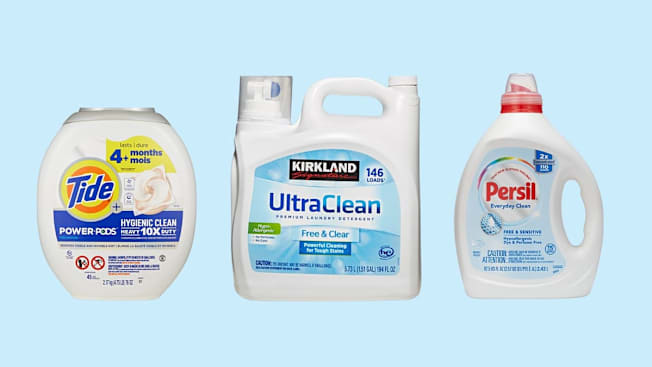How Well Do ‘Gentle’ Laundry Detergents Actually Clean?
We put sensitive-skin formulas from All, Dreft, Tide, and other popular brands to the test
When you shop through retailer links on our site, we may earn affiliate commissions. 100% of the fees we collect are used to support our nonprofit mission. Learn more.

Parents of young children—as well as adults with sensitive skin—face a particular challenge when it comes to doing laundry. They need a detergent that can effectively tackle tough stains, but that does so without the use of irritating or potentially harmful chemicals.
Finding a detergent that balances those needs can be a challenge, but choices are expanding. “It’s still a niche market, but there’s certainly an uptick of ‘free’ and ‘gentle’ laundry detergents across all major brands,” says Kelly Moomey, CR’s senior market analyst for detergents.
In our most recent laundry detergent tests, we included 19 detergents marketed for their gentleness. Most gentle liquid detergents received our Green Choice designation, which highlights the most environmentally friendly choices.
Many of these detergents’ labels feature buzzwords like “free,” “clear,” “hypoallergenic,” “sensitive skin,” or “pediatrician recommended” in making their claim of being beneficial for children and others with sensitive skin. When deciding which to include in our tests, Moomey says, “We focused on how detergent brands market and communicate with consumers, rather than on their ingredients.”
What Does ‘Free & Gentle’ Mean?
Of the detergents we identified as being marketed for their gentleness, more than half use the terms “free” or “gentle” in some form in their advertising. Detergents marketed as “free & gentle” are generally absent of allergen dyes, perfumes, optical brighteners, phosphates, phthalates, and 1,4-dioxane (a suspected human carcinogen), according to Eric Boring, PhD, a chemist in CR’s consumer safety testing program.
Can a Gentle Detergent Also Clean Well?
There is a potential trade-off: Gentle laundry detergents tend to use fewer stronger chemicals, which can help with effective cleaning. But are they effective enough?
In our tests, detergents branded “free,” “gentle,” or “clear” (or some combination of those words) earned Overall Scores that ranged from very good to just fair (which we consider an unfavorable rating). Kirkland, Tide, Persil, and All rank among the best gentle detergents, while Dreft, Arm & Hammer, Seventh Generation, and Target’s Up & Up Free+Clear disappoint.
Laundry sheets and powders performed the worst among gentle detergents, ranking mediocre at best and terrible at worst. Detergent sheets generally do not clean well, so we don’t recommend them. Consumers may have to weigh the need for a gentle detergent against cleaning performance, and then make a choice. “For those with sensitivity concerns, the lower cleaning performance may not be as important,” says Rich Handel, CR’s laundry expert.
Reading Beyond the Label
So, can you be sure that a detergent is gentle enough for you or your child just because it says it is, or because it has an adorable toddler pictured on the bottle?
Laundry detergents require surfactants, enzymes, and other chemicals to clean effectively. If you or your child has especially sensitive skin or specific allergies, you may have to read beyond the label.
“Parents should understand that their child still might be allergic to a detergent despite being called ‘free and clear’ due to the presence of allergens or irritant chemicals,” Boring says.
The Environmental Protection Agency’s Safer Choice label helps consumers find safer detergents by identifying those that meet criteria set by the EPA to protect human health and the environment and have also passed performance tests. You can also consult Smart Label, a resource developed by detergent brands and retailers that lists major detergent ingredients. Environmental Working Group’s gentle detergents list—with boutique brands like 9 Elements, Attitude, Better Life, and Common Good—identifies those that meet that organization’s standards for health and transparency. Laundry detergents with strong fragrances are among the most concerning items on EWG’s list.
How CR Tests Laundry Detergents
CR tests detergents, including liquids, pods, and sheets, for cleaning performance. Nearly a quarter of the detergents we tested claim to be gentle, skin-sensitive, or free of dyes and perfumes.
In our tests, we launder fabric swatches saturated with blood, body oil, chocolate, coffee, dirt, grass, and salad dressing—stains that are difficult to remove—to detect genuine differences among detergents. Our testers use a colorimeter (a device that measures color intensity) to compare detergent-washed swatch stains to identical swatches laundered using only water. We also assess how well detergents pretreat stains and clean in hard water.
Best Detergents for Kids and People With Sensitive Skin
Below you’ll find the best-performing laundry detergents marketed as gentle or free of certain chemicals. Consult the labels for the correct dosage, as detergents labeled 2X or 10X are more concentrated, meaning you don’t need as much for effective cleaning. Using too much can lead to excess residue on clothes, which could increase sensitivity.




























